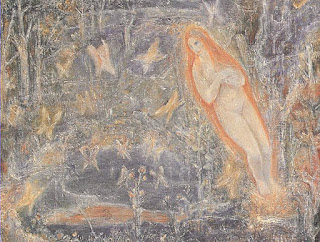Albert Bloch was an American Modernist artist and the only American artist associated with Der Blaue Reiter (Blue Rider), a group of early 20th-century European modernists. Bloch was born in St. Louis, Missouri to a German-Jewish family. Bloch was not raised in the Jewish faith, but would later adopt Christianity.
At the age of sixteen, Bloch dropped out of high school to study art at the St. Louis School of Fine Arts under Dawson Dawson-Watkins. Between 1905 and 1908 he worked as a caricaturist and illustrator for William Marion Reedy’s literary and political weekly The Mirror. Reedy noticed Bloch’s great talent, and provided him with a stipend to study art in Europe.
From 1909 to 1921, Bloch lived and worked mainly in Germany. During this time, he traveled extensively, though kept a home base in Munich. This choice was most likely due to his knowledge of the German language, which he learned from his parents.
In 1911, Bloch met Wassily Kandinsky and Franz Marc and was invited to show his work in their exhibit. Thus, Bloch officially became the only American to be involved in The Blue Rider group, and showed six canvases at their December 1911 exhibit at the Tannhauser Gallery. He was invited again to exhibit with The Blue Rider group in 1912, and enjoyed a successful career while living in Germany.
After the end of World War I, Bloch was disheartened with Germany and returned to the United States. He was in dire financial straits at this time, so he took up teaching at the Academy of Fine Arts in Chicago for a year. He would later accept a position as the Departmental Head position at the University of Kansas until his retirement in 1947. Bloch remained in the United States for the rest of his life writing, painting and teaching.
Like so many other European artists, Bloch’s oeuvre suffered greatly during World War I. The Nazi’s destroyed much of his art, deeming it degenerate, and may have stolen much of it as well. There is not telling how much stolen work of Bloch’s may be in existence somewhere in Europe or among descendents of Nazi soldiers. Bloch was also known to destroy any of his paintings that he did not think were acceptable, so many of those may have been saved from the rubbish from passers-by.
Bloch’s style and technique was consistent with that of Franz Marc and the other Blue Rider’s, using geometric forms, animals, religious subject matter and a soft, but bright, color palette. Many of his earliest works are rare, and to find one would be an extraordinary and valuable discovery.










































































































No comments:
Post a Comment